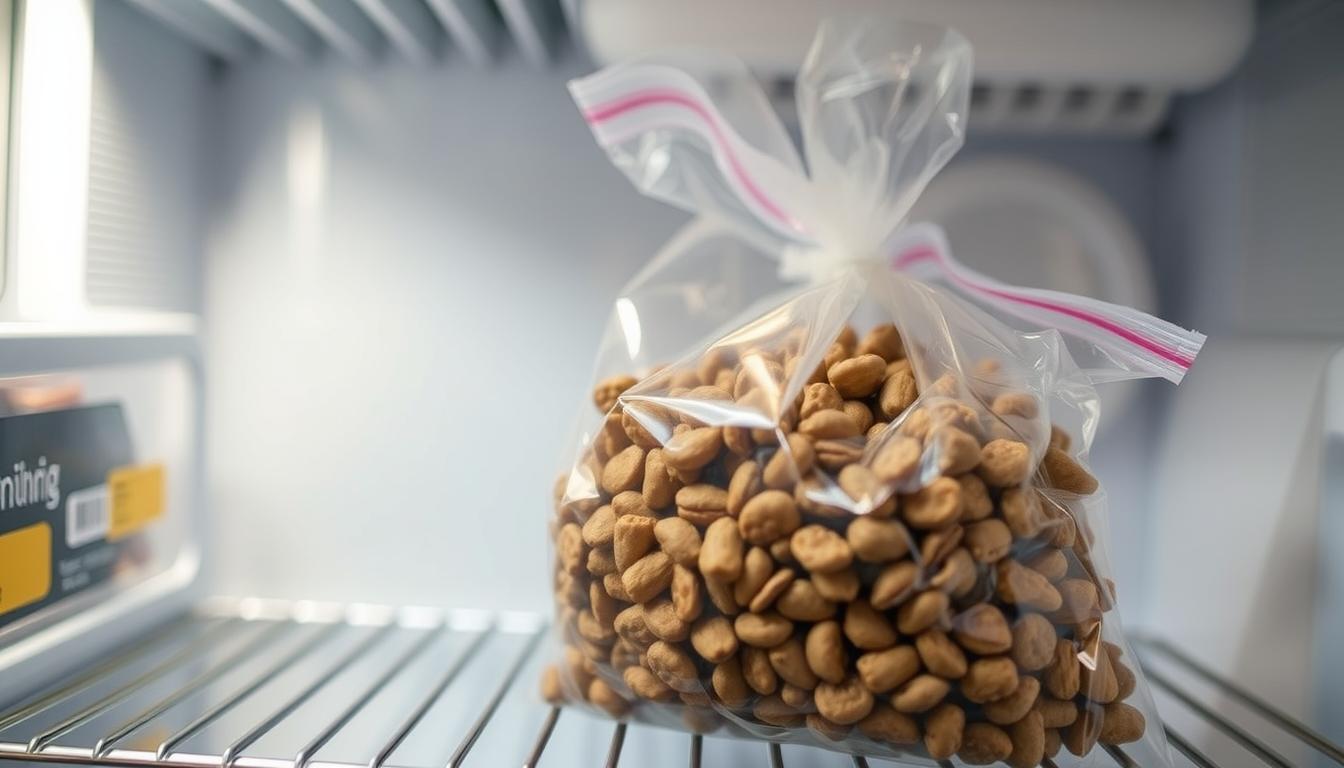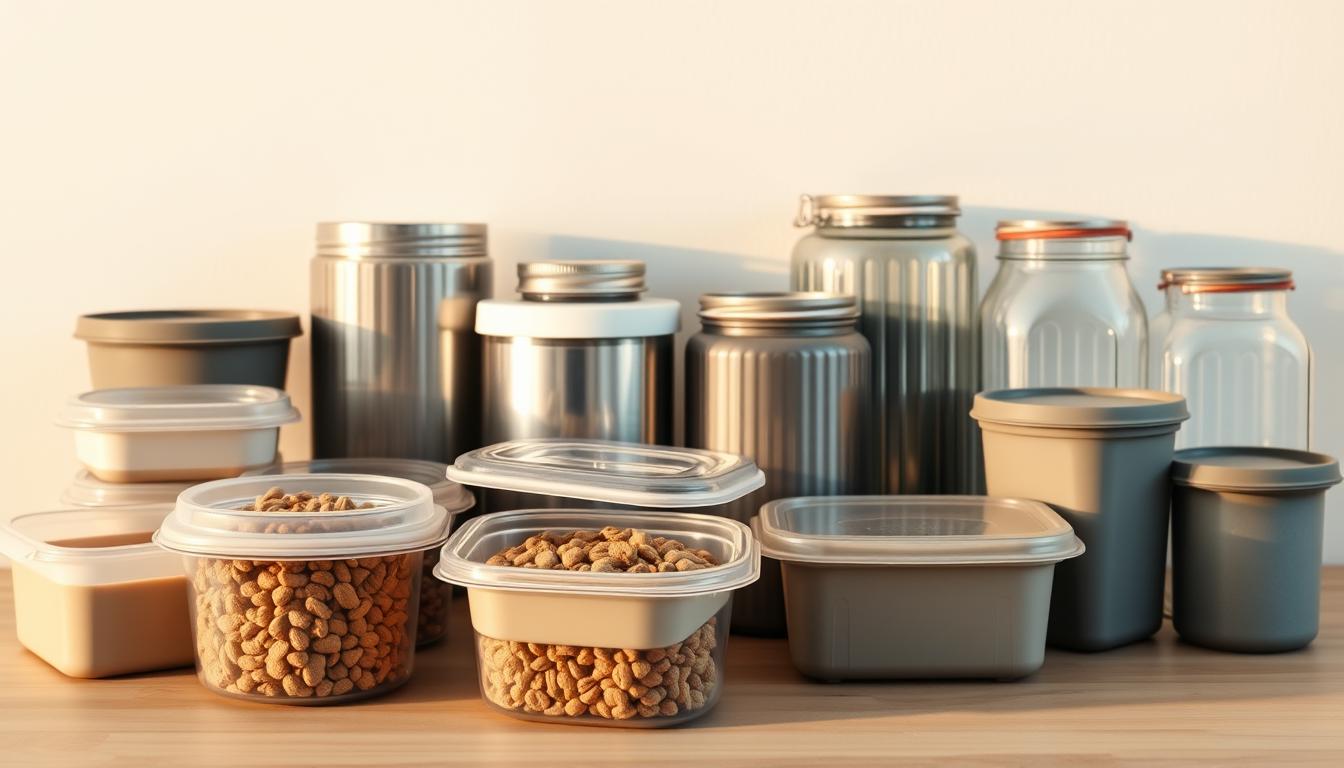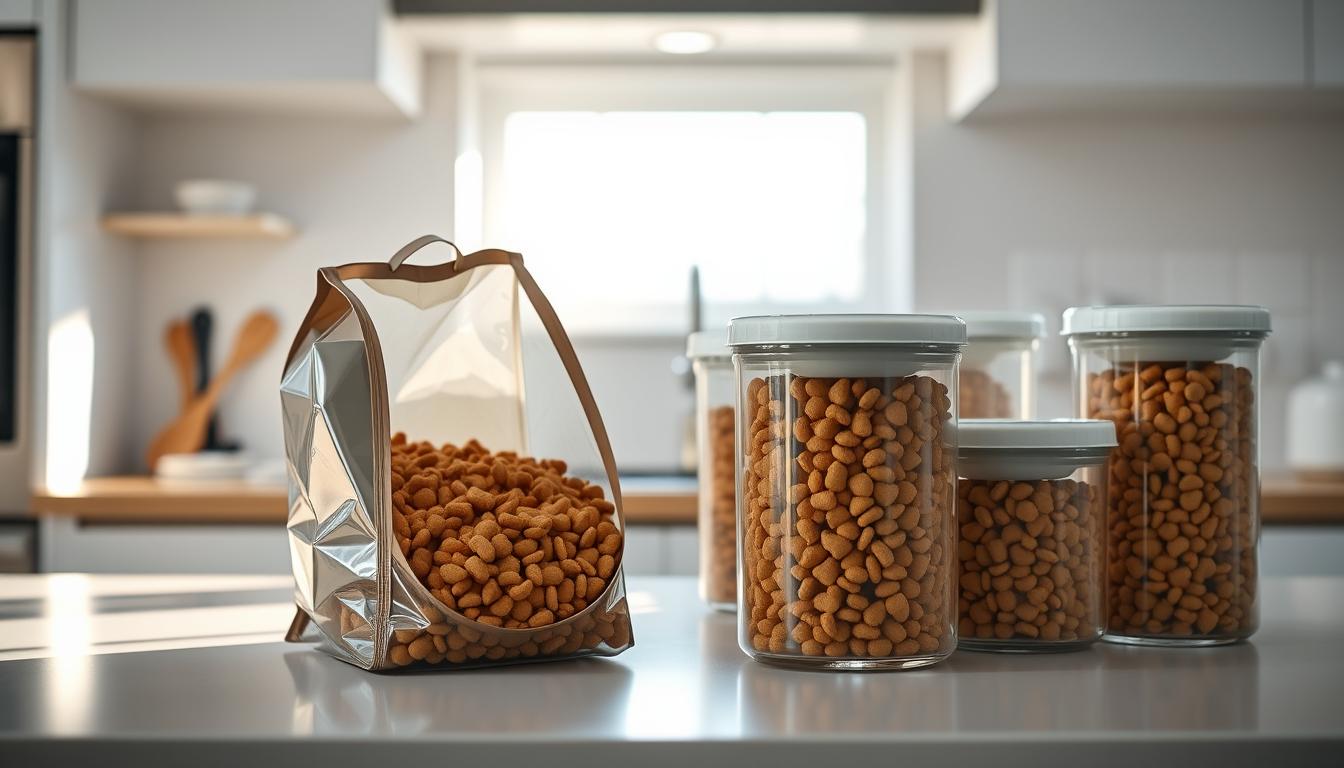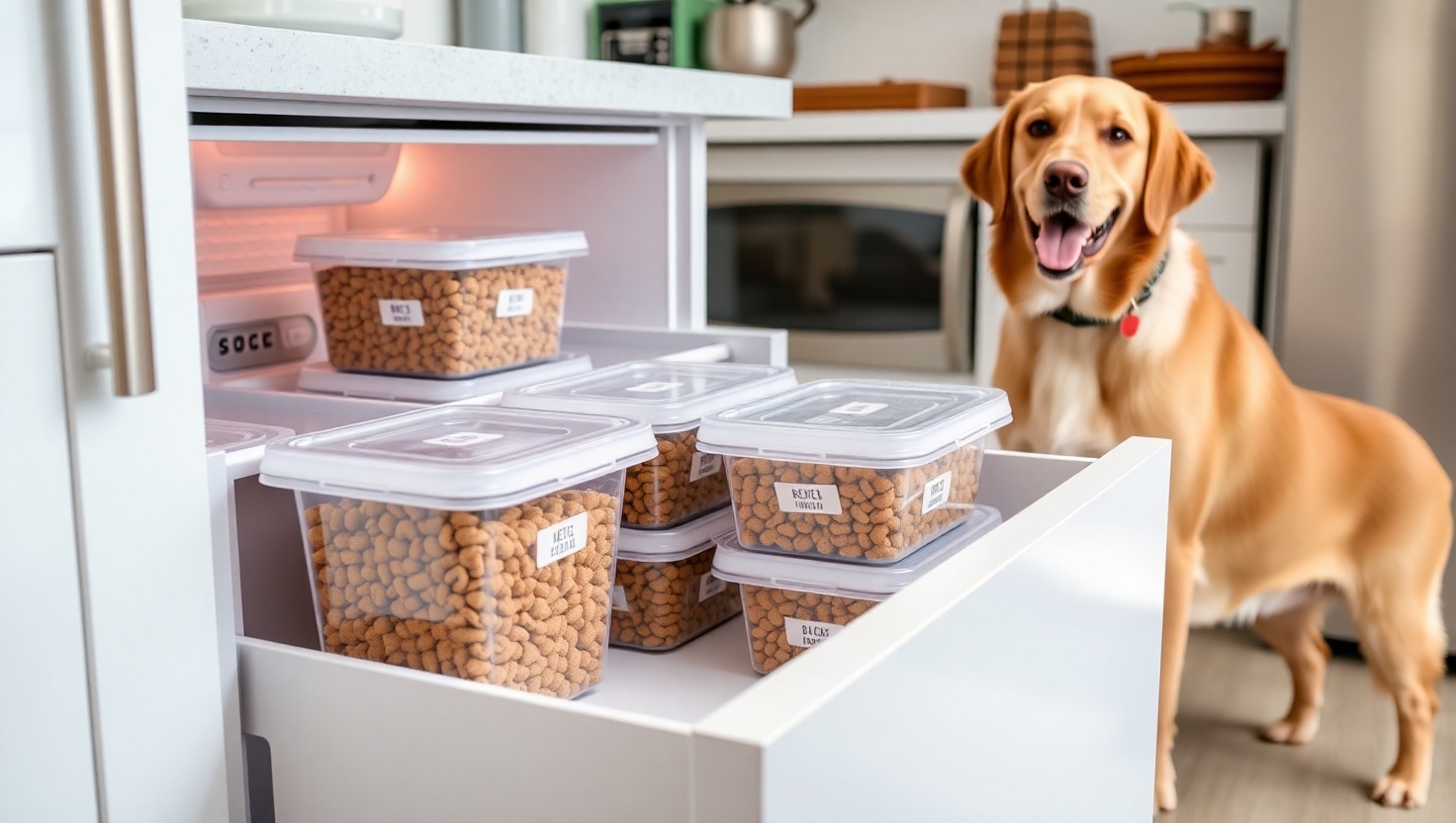
Did you know 60% of American pups struggle with weight issues? While exercise and portion control matter, how you handle meals plays a bigger role than many realize. Preserving nutritional quality in pet meals isn’t just about airtight containers – it’s about smart solutions that keep every bite as wholesome as the day it was packaged.
Modern pet parents are turning to cold-preservation methods to combat food spoilage and nutrient loss. This approach locks in essential vitamins and fats while preventing rancidity, especially in high-quality formulas with natural ingredients. When done right, chilled preservation can maintain meal quality for over half a year – a game-changer for bulk buyers or multi-pet households.
Key Takeaways
- Cold preservation extends nutritional value up to 9 months
- Proper techniques prevent harmful bacteria growth
- Reduces food waste by 30-40% for most households
- Maintains optimal fat and vitamin content
- Works best with oxygen-free packaging methods
Concerns about texture changes or freezer burn often hold owners back, but simple prep steps solve these issues. We’ll break down the science behind moisture control and temperature stability, showing how to adapt these methods for different breeds and dietary needs. Whether you’re managing a finicky eater’s meals or prepping for emergency situations, these strategies help ensure every bowl delivers maximum benefit.
Introduction to Freezer Storage for Dog Kibble
Your pup’s crunchy bites lose 40% of their antioxidants within three weeks if left in humid conditions. Dry dog food acts like a sponge, absorbing environmental moisture and odors that degrade its quality. “Once opened, every bag becomes a race against oxidation,” notes veterinary nutritionist Dr. Ellen Choi. This reality makes smart preservation vital for maintaining your pet’s meals at peak freshness.

Overview of Dog Kibble Storage
Temperature swings and light exposure accelerate nutrient breakdown in pet food. High-fat formulas particularly suffer, with omega-3 fatty acids deteriorating twice as fast in warm environments. The FDA advises keeping dry dog food in sealed containers below 80°F – a challenge during summer months or in heated homes.
Traditional storage often fails bulk buyers. Those 30-pound bags? Once opened, they’re exposed to air until the last scoop. This constant oxygen exposure turns protective fats into harmful free radicals over time.
Why Best Practices Matter for Your Pet
Proper handling preserves the crunch and aroma dogs love while safeguarding essential nutrients. A 2023 study found pets eating optimally stored kibble had 18% better vitamin E absorption. As Dr. Choi emphasizes: “What good is premium nutrition if it arrives oxidized in the bowl?”
Different kibble types demand tailored approaches. Fish-based formulas need stricter moisture control than poultry recipes. Grain-free varieties often require cooler temperatures to prevent oil separation. Matching your storage strategy to your pet’s specific food ensures every meal delivers maximum benefit.
Understanding Freezer Storage for Dog Kibble
Preserving your pet’s meals at peak quality requires more than just a cool pantry. Low-temperature methods create a protective environment that maintains texture and taste while locking in essential nutrients. Let’s explore how this approach keeps every bite as fresh as day one.
Benefits of Chilling Dry Formulas
Cold environments dramatically slow oxidation – the process that turns healthy fats into harmful compounds. A 2024 Animal Nutrition Journal study found chilled formulas retained 92% of their original omega-3 content after six months, compared to 58% in room-temperature conditions.

This method also tackles invisible threats. “Chilling stops mite eggs from hatching,” explains veterinary researcher Dr. Lisa Monroe. “It’s particularly helpful for pets with sensitive skin or allergy concerns.” The table below shows how different preservation methods compare:
| Method | Nutrient Retention | Mite Prevention | Duration |
|---|---|---|---|
| Room Temperature | 65% | None | 4-6 weeks |
| Refrigeration | 78% | Partial | 3-4 months |
| Cold-Preservation | 91% | Complete | 6-9 months |
Pre-Chill Checklist
Before portioning meals, consider these factors:
- Current expiration dates – never preserve expired products
- Bag seals – ensure original packaging remains intact
- Moisture content – check for clumping or unusual odors
High-fat formulas benefit most from cold methods, while grain-free varieties need careful moisture monitoring. Always consult your food’s manufacturer guidelines – some recommend specific temperature ranges for optimal results.
The Importance of Proper Dog Food Storage
Your pet’s health starts long before mealtime—it begins with how you safeguard their nutrition. Smart preservation methods protect vital nutrients while creating a barrier against environmental threats. Let’s explore why this daily habit impacts everything from your companion’s shiny coat to their immune system resilience.

Preserving Nutritional Value and Freshness
Essential fatty acids and vitamins degrade rapidly when exposed to air. A 2023 Veterinary Medicine Today study revealed improperly stored meals lose 34% of vitamin E within 30 days—nutrients crucial for skin health and disease resistance. Oxygen-resistant containers and climate control help maintain these delicate compounds.
Fat-soluble vitamins (A, D, E, K) are particularly vulnerable. These nutrients support vision, bone density, and blood clotting. When oxidation occurs, they transform into ineffective forms that pets can’t utilize. Regular rotation of stock ensures your companion receives maximum benefit from every bite.
Minimizing Risks from Moisture and Pests
Humidity turns crunchy meals into breeding grounds for mold within 72 hours. Dr. Sarah Wilkins, a board-certified veterinary nutritionist, notes: “Even 5% moisture content allows toxic mycotoxins to develop—silent threats that standard expiration dates don’t address.”
Rodents and insects seek out poorly sealed packages, introducing harmful bacteria like salmonella. Airtight solutions prevent infestations while maintaining texture. For households buying in bulk, proper methods can reduce waste by 40%, making premium nutrition more affordable long-term.
Practical Steps for Freezer Storage
Ever opened a bag of pet meals only to find them stale weeks later? Proper cold-preservation techniques solve this common frustration while keeping nutrients intact. Let’s explore three key phases that ensure every scoop stays fresh and flavorful.

Pre-Freezing Preparations
Start by checking your current supply. Look for broken pieces, unusual odors, or discoloration – these indicate compromised quality. Separate portions based on your companion’s daily needs. Meal-sized batches prevent repeated exposure to temperature changes.
Choose durable materials that block moisture. Glass jars with silicone seals work better than plastic for long-term preservation. Always leave 1-inch headspace – expansion during chilling can crack rigid containers.
Step-by-Step Freezing Process
1. Portion meals using measuring cups
2. Fill containers ¾ full
3. Remove excess air from bags
4. Label with preparation dates
Double-bagging adds extra protection against odor absorption. Place newer batches behind older ones in your cold-storage area. This rotation system ensures you always grab the oldest stock first.
Thawing and Using Frozen Meals
Move portions to chilled storage 24 hours before serving. Never thaw at room temperature – gradual warming prevents condensation. Once opened, keep thawed meals in sealed containers and use within 5 days for best texture.
Pro Tip: Mark original expiration dates on labels. Even frozen products have shelf limits – typically 6 months for optimal freshness. Regular checks help maintain quality and safety standards.
Choosing the Right Storage Containers
What’s the secret to keeping every scoop as fresh as the first? Your container choice makes all the difference. Proper preservation requires materials that block air and moisture while fitting your space and lifestyle.

Airtight Containers vs. Original Packaging
Manufacturer bags offer convenience but limited protection. While some feature resealable tops, most aren’t designed for long-term use. Airtight solutions create an extra barrier against humidity and pests while preserving texture.
Consider this comparison:
| Option | Protection | Space Use | Info Access |
|---|---|---|---|
| Original Bag | Basic | Bulky | Full details |
| Dedicated Container | Superior | Compact | Requires label |
The AAFCO advises keeping meals in their original bag inside containers. This hybrid approach maintains batch numbers and expiration dates while boosting freshness.
Recommendations for Effective Storage
Stainless steel outperforms plastic for durability and odor resistance. Look for FDA-approved materials with silicone gaskets. Ideal containers should hold 1-2 weeks of portions to limit air exposure.
- Square shapes maximize space better than round
- Transparent lids help monitor supply levels
- Wide mouths simplify cleaning
Dr. Rachel Torres, veterinary food safety expert, notes: “Containers with measurement markings reduce overfeeding risks by 22%.” Pair your chosen solution with oxygen absorbers for maximum nutrient retention.
Maintaining Freshness and Nutritional Value
Your nose knows first when pet meals turn – that faint rancid odor means trouble. Keeping formulas at their best requires sharp observation and proactive habits. Let’s explore how to spot red flags and create defense systems against quality loss.

Spotting Trouble Before It Spreads
Watch for these warning signs in preserved meals:
- Sour or metallic smells indicating oxidized fats
- Discolored pieces or dusty residue at container bottoms
- Unexplained clumping from moisture intrusion
Pets often reject compromised meals before owners notice changes. “If your companion walks away from their bowl, investigate immediately,” advises veterinary technician Mara Simmons. Sudden digestive issues after meals demand immediate inspection of your preservation methods.
Hygiene Habits That Protect Quality
Residual oils in containers become breeding grounds for bacteria. Wash all vessels with hot water and dish soap weekly. For stubborn residues:
- Soak with white vinegar for 15 minutes
- Scrub with baking soda paste
- Air-dry completely before refilling
Dr. Emily Carter, food safety specialist, notes: “Biofilm develops in poorly cleaned containers – invisible layers that contaminate new batches.” Rotate cleaning tools to avoid cross-contamination from sponges used on other surfaces.
Temperature’s Role in Nutrient Preservation
Consistent cold conditions prevent vitamin breakdown. Fluctuations above 0°F degrade:
- Vitamin E stability by 12% per month
- Protein digestibility by 8% quarterly
Use oxygen absorbers in vacuum-sealed packs to maintain nutritional value for 9+ months. These small packets remove 99% of air, slowing spoilage while preserving freshness and texture. Label packages with “opened on” dates to track optimal usage windows.
Comparing Freezer Storage with Alternative Methods
Choosing how to preserve your companion’s meals could impact their health more than you think. While the FDA recommends keeping unopened packages in dry areas below 80°F, real-world conditions often demand smarter solutions. Let’s explore how various approaches stack up in protecting nutritional quality.
Cold vs. Ambient Environment Solutions
Room temperature preservation works short-term but fails long-term nutritional goals. Formulas left in pantries lose 22% more antioxidants monthly compared to chilled alternatives. Garages and sheds prove worst – summer heat accelerates fat breakdown, creating rancid odors pets avoid.
| Method | Shelf Life | Cost Efficiency | Space Needed |
|---|---|---|---|
| Pantry | 4-6 weeks | $0 | Moderate |
| Room Temp | 2-3 months | Low | Flexible |
| Cold-Preserve | 6-9 months | Medium | Significant |
Evaluating Your Options
Bulk buyers gain most from cold methods despite higher upfront costs. A 30-pound bag preserved properly saves $18 monthly through reduced waste. Urban dwellers with limited space might prefer vacuum-sealed pantry containers.
Climate plays a crucial role. Humid coastal homes need moisture-proof solutions, while arid regions can prioritize oxygen barriers. Rotate stock every 3 months regardless of method – even the best techniques can’t stop time’s effects on nutrients.
Preparing for Long-Term Storage and Emergencies
When emergencies hit, your furry friend’s nutrition shouldn’t be an afterthought. Proper planning ensures meals stay safe and nutritious through power outages or natural disasters. Let’s create a system that protects your companion’s wellbeing when unexpected situations arise.
Stock Rotation and Checking Expiration Dates
Implement a first-in, first-out system to maintain freshness. Label containers with purchase dates using waterproof markers. Check dates monthly and move older stock to accessible front positions. This simple habit reduces waste by 37% according to pet food safety studies.
| Storage Method | Optimal Duration | Rotation Frequency |
|---|---|---|
| Original Packaging | 6 months | Every 3 months |
| Oxygen-Free Containers | 12 months | Every 6 months |
| Cold-Preserved | 18 months | Annual check |
Calculate your household’s needs based on:
- Companion’s weight and daily portions
- Local climate risks (floods, storms)
- Multiple pet requirements
Dr. Angela Ruiz, emergency veterinary specialist, advises: “Store dry formulas in airtight containers with silica packs – this combo extends shelf life best during crises.” Pair your meal reserves with backup water supplies and portable bowls for complete readiness.
Conclusion
Protecting your companion’s nutrition requires both science and strategy. By applying the methods we’ve discussed, you’ll preserve essential nutrients in dry dog meals while extending their freshness window. These techniques work best when paired with quality containers and consistent rotation habits.
Your efforts directly support your pet’s health – maintained vitamin levels and stable fats mean better energy and coat quality. While cold-preservation plays a key role, remember it’s part of a larger care ecosystem. Pair these practices with regular vet checkups and mindful feeding routines.
Investing in proper handling pays dividends beyond meal quality. You’ll reduce waste from spoiled batches and gain flexibility in bulk purchasing. Most importantly, you’re ensuring every bowl delivers the nutrition your loyal friend deserves.
Keep this guide handy as you refine your approach. With attention to detail and these evidence-based methods, you’ll master the art of preserving kibble’s crunch and nutritional power. Here’s to happy, healthy mealtimes ahead!
FAQ’s
Can freezing dry kibble extend its shelf life?
Yes! Freezing helps lock in nutrients and freshness, especially for large bags. It slows oxidation and keeps fats from going rancid. Just use airtight containers to avoid moisture absorption.
How should I prepare kibble before freezing?
Portion meals into smaller servings to reduce air exposure. Remove excess air from resealable bags or use vacuum-sealed containers. Label packages with dates to track freshness and rotate stock.
What containers work best for freezing?
Opt for airtight, BPA-free plastic bins or glass jars with tight seals. Avoid flimsy packaging that lets in humidity. Brands like OXO and Rubbermaid offer durable, pet-safe options.
Can I refreeze thawed kibble?
It’s not recommended. Repeated thawing can lead to texture changes and bacterial growth. Thaw only what your pet will eat within 1-2 days to maintain quality.
How does cold storage compare to room temperature?
Cold storage preserves nutrients longer and deters pests like pantry moths. Room temperature is convenient but risks spoilage in humid climates. Use pantry storage for short-term needs only.
How long can kibble stay fresh in cold storage?
Up to 6 months if sealed properly. Check expiration dates and use older batches first. Discard if you notice clumping, discoloration, or off smells.
How can I tell if frozen kibble is still safe to use?
Look for mold, unusual odors, or a greasy texture. Fresh kibble should retain its original color and crunch. When in doubt, toss it out to avoid health risks.
Also Read:


